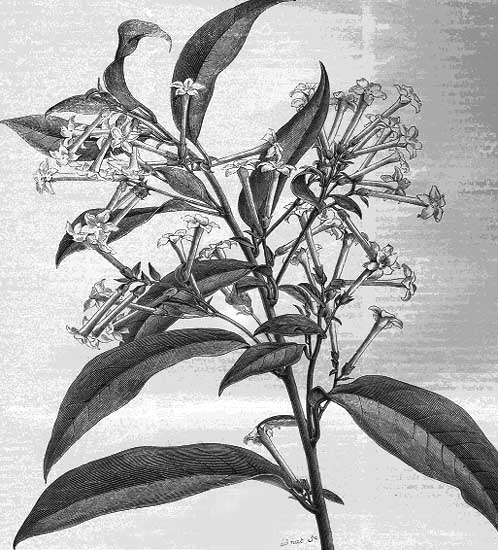
Synonymy
*Cestrum nocturnum L., Sp. Pl. 1: 191 (1753)
T: `Habitat in Jamaica, Chilli'; Lectotype : Baeck s.n., Herb. Linn. No. 258.1 (LINN) fide Deb in J. Econ. Taxon. Bot. 1 : 36 (1980).
The previous indication of W.G.D'Arcy, Ann. Missouri Bot. Gard. 60: 607 (1973) of material in the Clifford herbarium was found not to be correct. See the Linnaean Plant Name Typification Project pages for further details.
Description
Large shrub or small tree to 4 m; young twigs sparsely pubescent.
Leaves lanceolate-elliptic; lamina 10–15 cm long, 4–7 cm wide, the midrib pubescent below; petiole 5–10 mm long.
Inflorescence an often congested, terminal, leafy panicle of spike-like racemes; flowers numerous, sessile or on pedicels to 3 mm long, subtended by leafy, linear bracts 3–10 mm long. Calyx c. 2.5 mm long; lobes triangular, c. 0.8 mm long. Corolla greenish-yellow, slightly enlarged upwards; lobes c. 4 mm long. Stamens inserted in upper half of corolla-tube; filaments c. 3 mm long, with an erect process just below point of insertion, retrorsely pubescent where adnate to tube; anthers 0.5 mm long. Style 15–16 mm long.
Berry 8–10 mm diam., white, ?turning red with age. Seeds prismatic, c. 4 mm long.
Distribution and ecology
Sparingly naturalised in Paramatta and Maitland areas in N.S.W., Atherton and Brisbane in Qld, Hilltown in S.A. and on Lord Howe Is. Native to the Antilles and Central America.
Common name
Lady of the night, Night jessamine, Queen of the night
Notes
Widely cultivated in tropical areas for the strongly scented flowers.
Reported as toxic to stock but possibly in error for C. parqui L'Hér.
Selected specimens
N.S.W.: East Maitland, 5 Feb. 1974, Lynch (NSW).
Derivation of epithet
From Latin nocturnum, - of the night, a reference to the flowering time or possibly to the aroma this species produces in the evening.
Images and information on web
Images of C. nocturnum can be accessed through the Digital Flora of Texas and through CalPhotos.
Information about this species as a weed in in New Zealand can be seen on their Weedbusters site at http://weedbusters.co.nz/weed_info/detail.asp?WeedID=83
C. nocturnum as a weed in the Pacific is treated on the Pacific Island Ecosystems at Risk (PIER) site.
A pressed specimen of C. nocturnum can be seen on the Plants of Hawaii site and further information with an image can be found at a Florida site at http://www.floridata.com/ref/c/cestrum.cfm
An early painting of C. nocturnum (as C. suberosum) from Jacquin's Plantarum rariorum horti caesarei Schoenbrunnensis descriptiones et icones can also be seen on the rare book site of the Missouri Botanic Gardens.
A line drawing of C. aurantiacum and C. nocturnum is shown on the Flora of China page at http://digitalis.mobot.org/mrsid/296/29602084_001.gif
Further information about the toxic properties of this plant can be found with a search in the FDA Poisonous Plant Database